All about growing a climbing rose

A luxurious climbing rose looks beautiful and unusual. The plant is very popular with many flower growers. When cultivating it, it is very important to observe all the necessary agrotechnical rules, to provide competent care for the planting. In this article, we will learn all about the correct cultivation of a climbing rose.


Landing features
Growing a climbing rose involves many rules. They cannot be neglected in any case, if you want the culture to grow beautiful and healthy. Before planting luxurious flowers, the gardener needs to consider how to plant them correctly on his site. Let's figure out some of the nuances of this important process.
- Saplings of beautiful climbing shrubs are often sold with an open or closed rhizome system... Closed-root versions are usually found in special containers. They can be planted directly into the ground along with an earthen clod. But it must be borne in mind that it is simply not possible to check the roots and soil of the "closed" seedlings. If the seedlings were purchased from an unverified seller, then they must be properly stored before the planting procedure.
- For this, the soil in the container must be watered with a special insecticide "Aktara". The above-ground part should be sprayed with Ordan fungicide. Containers with seedlings should be sent to a room where the temperature does not exceed +3 degrees.
- The same seedlings that have an open rhizome system can immediately be planted in their permanent place in the open field.... Such procedures should be started no earlier than the next day after the purchase. Leaving plants outdoors is not permitted.
- Seedlings with open roots also need to be prepared for transplanting to the site. To do this, the culture is soaked in water for a day. After that, the plants are taken out and healthy roots are cut off up to 30 cm. All damaged or diseased elements must be completely removed. The same roots that just rotted are shortened to healthy areas.
- The aerial part of the planting material is cut to 30 cm. Broken and weakened shoots are removed. It is necessary to cut off the leaves and buds that are on the line below the scion. Areas with cuts are sprinkled with crushed activated carbon. The roots are disinfected by dropping in a 3% solution of copper sulfate.
After that, the root system of the culture must be treated with special preparations that stimulate growth.
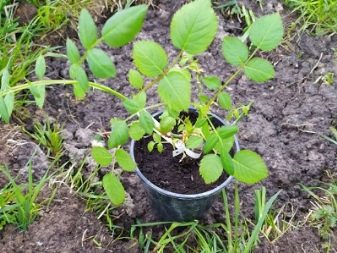

When the seedlings are fully ready for planting, the summer resident will have to choose the optimal place for them in the garden. It is best to plant the climbing rose in those areas that are located on the south or southwest sides. Let's consider what other parameters are worth paying attention to.
- For a climbing rose, you should select well-lit areas... The landing zone should be flat, but with a slight slope. There should also be some shading in the afternoon.
- The planting area must be well ventilated, but protected from drafts or too strong winds.
- The place should also be dry enough. Damp and waterlogged soil layers can quickly lead to decay of the climbing rose root system.
- The plant can be planted along a line along a fence, near a wall or arch. In places like this, culture is quickly becoming a vibrant focus in landscape design.However, it must be borne in mind that here the roots and the ground part of the plant should have enough free space for further growth and development. A flower should be planted 50-100 cm from the support base, as well as half a meter from other garden plantings.
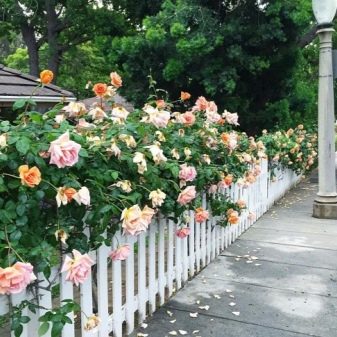

Before planting a climbing rose, the gardener needs to properly prepare the soil for this on the site or in the flower bed.
- First, the earth is dug to a depth of 50 to 70 cm. All weed roots are removed.
- To increase fertility indicators, add to the soil humus, as well as humus or peat compost.
- If the soil mixture is clayey, then it will need to be pre-diluted with a mixture of coarse sand, humus, compost, sod and leafy soil in proportions of 6: 1: 1: 1: 1. Sandy soil should be mixed with clay, sod, as well as compost and humus. In this case, the proportions should be as follows - 2: 2: 1: 1.
- If the acidity of the soil is too high, then the planting soil mixture can be diluted with dolomite flour.
- On soils of the chalky type, as well as in those areas where other varieties of roses previously grew, it will be necessary to remove about 50-70 cm of the upper layer of the earth. You can also dig a hole measuring 60x60x45 cm.
The soil should be replaced with a suitable soil mixture of equal volume of turf and peat, as well as 500 g of bone-type flour.
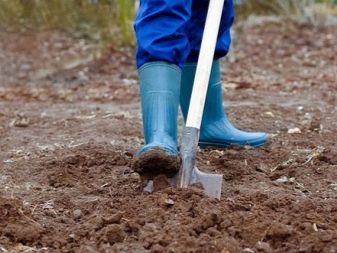
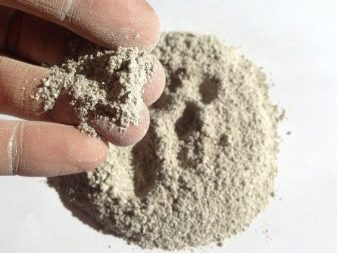
When everything is ready, you can proceed directly to planting.
- Dig a hole, the size of which is 50x50 cm. The optimum depth is from 60 to 65 cm. A distance of 2-2.5 m should be maintained from other rose bushes.
- A small amount of soil mixture is poured into the bottom of the dug hole. It is necessary to form a neat mound.
- Now the gardener will need to very carefully spread the roots of the seedling. They should be placed in the fossa so that they do not rise upward. If the bush is planted in the immediate vicinity of the support base or wall, then the roots must be positioned so that they "look" in the opposite direction from the specified elements.
- If the roots of the seedling are closed, then it will need to be carefully removed from the container., and then plant it in the hole along with the existing lump of earth.
- The hole is sprinkled with earth for 2/3, after which it is tamped.
- Next, you will need to pour 0.5 buckets of waterto eliminate any remaining voids.
- The space that remains free is covered with soil mixture. In this case, it is necessary to deepen the vaccination site by 10-12 cm. Then the soil is compacted again. Pour another 0.5 buckets of water.
- As soon as all the liquid is absorbed into the soil, a special planting mixture is added. The seedling is spud. In this case, the stalk should be covered by 20 cm in the spring, and in the fall - by 25-30 cm.
- The trunk circle is carefully mulched with the help of needles.
- To achieve better and faster rooting, the climbing rose seedling is covered with a film to create greenhouse conditions. The film should be lifted daily to ventilate the planting.
- After a week, the shelter can be removed... After that, the gardener will need to tackle the branches of the rose to the supporting components.
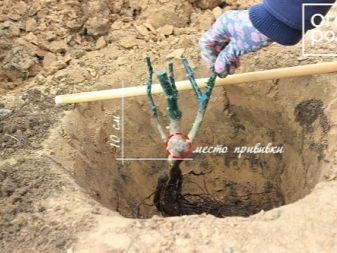
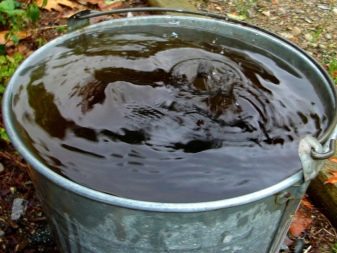
Garter
Garter is a care procedure that is necessary for a climbing rose. Trellises, reinforcing parts, wooden pillars, a metal lattice, or a light plastic mesh can be used as a supporting base. It is easiest to tie a plant with sufficiently long shoots to such components. With the help of the winding culture, various small architectural foundations are very often decorated. We are talking about arches, pergolas, gazebos and so on.
The stalks of a beautiful plant are tied up using plastic fasteners. You can also use twine or wire made of non-metallic material. Shoots should not be overtightened with garters, as this will hinder their growth. As the branches grow back, the procedure is repeated, and the lower loops are made weaker.With the help of support bases and a competent garter, the climbing rose bushes can be given almost any attractive shape. So, in order to give the bush an aesthetic structure of the pillar, certain actions are required..
- From 3 to 5 long pegs of wood are driven into the ground. Metal rods are also suitable. These components are fixed in a circle, and then covered with a mesh.
- The structure is wrapped with young shoots in a spiral. After that, they are securely and beautifully fixed.
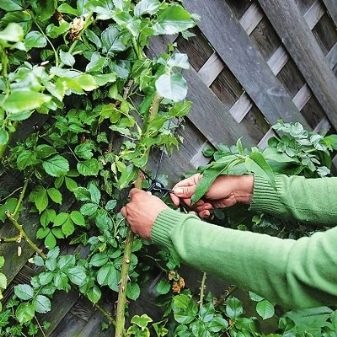
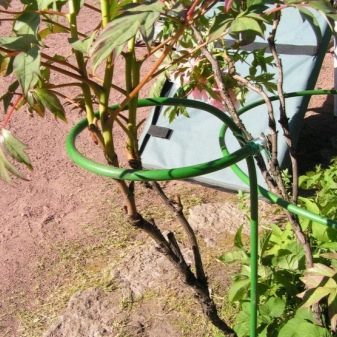
Top dressing
Caring for a climbing plant provides for mandatory feeding. Those plants that were planted in spring do not need this. If there is a desire, in the first year in summer, shrubs are allowed to feed with a tincture of cow dung and water in proportions of 1: 10. Chicken droppings are also suitable - 1: 20. Fertilizers are consumed in the amount of 3 to 5 liters for each bush.
In the second and subsequent years, a beautiful culture is fed.
- After removing the winter shelter after 2 weeks... To do this, you should use 1 tbsp. l. ammonium nitrate. This component is introduced under each bush, after which watering is performed.
- Top dressing is needed when budding. Complex fertilizers are suitable, which contain nitrogen.
- It is important to feed the plant before flowering. To do this, use tinctures from cow dung or chicken droppings.
- After the first flowering, the climbing rose is fertilized with a combination of 10 g of potassium sulfate and 25 g of superphosphate... Dilute these drugs in a bucket of water. Fertilizer is consumed in the amount of 3-5 liters for each bush.
- When the plant blooms at the end, it also needs to be fed. In the period from late summer to early autumn, superphosphates are added.
The consumption of these drugs should be about 30 g per square meter.
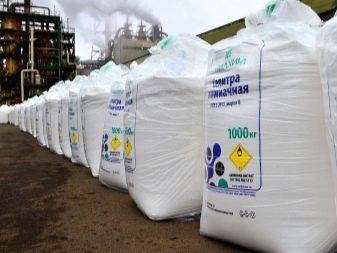

The nuances of trimming
Pruning is an important grooming procedure that must be addressed when growing a climbing rose in the country. The formation of the bush must take place correctly. Spring pruning is carried out according to a certain pattern.
- First, the summer resident needs remove all covering materials, remove dry, weakened and sluggish branches.
- In a once-flowering culture, the stems are shortened, leaving only 1 strong kidney. The shoots on the sides are cut by 2/3.
- If the plant blooms several times, then it is necessary to leave from 3 to 7 sufficiently strong young branches. In this case, the old elements are cut to the very base.
- Absolutely all cutting zones are processed special garden pitch.
Summer pruning should also be done according to the rules.
- If culture single bloomingto provide it with an attractive design, the basal branches are cut to the very base.
- If culture re-blooming, then it is necessary to remove all faded components up to the first five-leafed leaf, which is located at the top of the stems.
- Escapes on the sides of all types of roses are shortened by about 2-3 buds.
- Cut Zones coated with garden var.
Consider how to properly prune in the spring season.
- If the variety small-floweredin order to arrange it neatly, you will need to remove all dried leaves, as well as buds that have already faded. Wild growth is also removed along with damaged branches.
- If the variety large-flowered, then pruning of weak shoots is required. To form a culture correctly, you should leave 3 young shoots, as well as up to 7 old flowering elements. All other stems are cut to the very base.
- As in the cases discussed above, the cut surfaces processed with garden var.
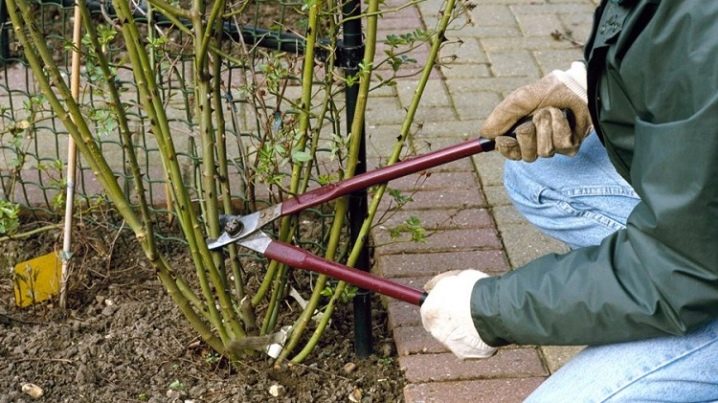
Transfer
If the plant in question, subject to proper care, still grows poorly or often gets sick, then this will indicate the wrong choice of place for planting it. In this case, the culture should be transplanted. It is best to do this in the fall or spring, before the buds are awakened. You can plant a rose in this way:
- the branches of the plant are removed from the support base;
- if the crop belongs to the "climber" or "climing" group, then all its shoots must be shortened to ½ the length, if the plant belongs to the "ramblers" group, then its 2-year-old branches are removed altogether, and the young ones are left;
- the bush is dug around its entire circle, making an indent of 50-60 cm from the trunk;
- then the bush is dug out without affecting the root system;
- the roots are gently shaken off, after which the culture is transplanted to its new place;
- the soil is tamped, and then the rose is watered, after 4-5 days the earth will settle after transplantation. After that, you should add more soil and spud the bush.

Shelter for the winter
The summer resident should be responsible for the correct preparation of the rose for the upcoming wintering. Let's consider how to make a shelter for the culture so that it does not freeze.
- In the last days of August, it is necessary to stop watering the bush.... The application of fertilizing components should also be stopped.
- Before the arrival of the first frost, you will need to carefully remove the branches of the climbing rose from the supports. They are wrapped with rope and try to bend them.
- If there is a risk of breaking the stems, then it is better to fix them in their original position. Let the shrub stand in this form for 2-3 days, and then you should continue until it completely settles on the ground. You can fix the elements of the rose with pegs or wire.
- The soil near the trunk circle is sprinkled with fallen leaves or spud with dry earth.
- When frosts come, the plant must be covered with lutrasil. If the culture is located in a region where winters are especially cold (for example, in Siberia), then the branches of the rose must be overlaid with spruce branches, and then wrapped with special agrofibre.
- In those areas where winter is warmer and more comfortable, it is enough just to cover the climbing shrub with spruce branches, and also wrap it with burlap and twine... In this case, there is no need to remove the supporting structures.
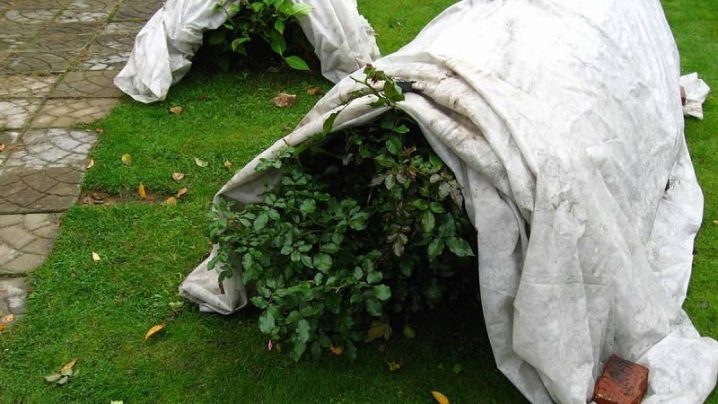
How to propagate?
There are several main ways to propagate a climbing rose. Let's get acquainted with the main features of each popular method.
Cuttings
You can dilute a climbing rose through the grafting procedure. This method most often leads to the desired results. Let's consider how it should be correctly implemented.
- In summer, spring or fall season suitable cuttings no more than 15 cm long are cut from semi-freshened shoots. 2-3 internodes should be left on each of them.
- The lower part of the cutting is cut at an angle of 45 degrees, departing from the kidney at least 5 cm. Above the kidney, 1 cm is made another cut, but at an angle of 90 degrees.
- The leaves are removed entirely from the bottom, and the upper ones are cut in half.
- The containers are filled with disinfected sand, humus, peat in proportions of 1: 1: 1. The cuttings are buried 2 cm, and then covered with jars or foil.
- The containers are sent to rooms where the temperature is set to plus 23-25 degrees. The sun's rays should not fall on the landings.
- The room is sometimes ventilated and watering the seedlings.
- After 2-3 weeks, a jar or film take away.
- Further seedlings can be transplant to their main place.
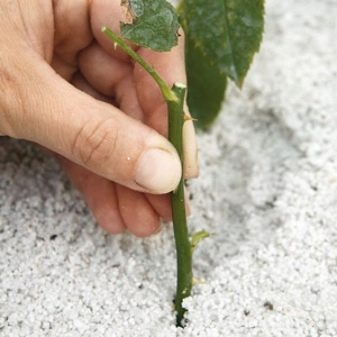
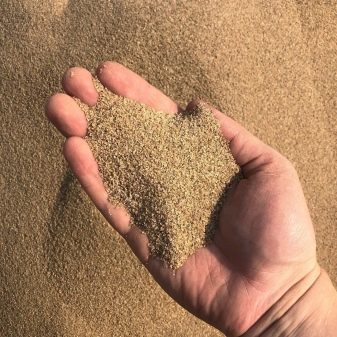
Budding
This breeding method is implemented as follows:
- on the root collar of a 3-year-old plant, do T-shaped notch, in this case, the edges of the bark should be slightly pulled back;
- with scion a kidney is cut off with the bark, do this together with a piece of wood itself;
- the bud is placed in the rootstock incision, press firmly, and then wrap with foil;
- they spud the bush in this way so that the soil mixture covers the vaccination site by at least 5 cm;
- a month later, the film is weakened, and in the spring they are removed altogether;
- during the first year, the grafted rose is not allowed to bloom, break off the buds that are forming;
- the grafted plant will need standard care - it is watered, fertilized, mulched, covered for the winter.

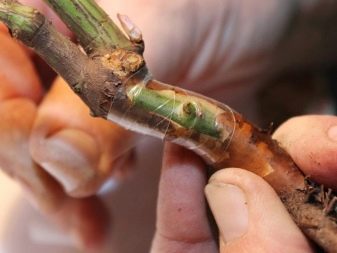
Seeds
We will find out how the procedure for propagating a climbing rose from seeds takes place.
- In mid-late February, sowing materials pour 3% hydrogen peroxide.
- After 30 minutes, they are taken out, placed between a pair of sponges, also soaked in peroxide... The components are wrapped in film and sent to the refrigerator shelf.
- Sometimes seedlings should be inspected to assess their condition. If mold appears, then the sponges are replaced with new ones.
- After 40-50 days, the germinated seeds are planted in plastic cups with a special soil for roses. It is enough to deepen the seedlings by only 1 cm. The containers are covered with foil and placed on the windowsill.
- The film is slightly opened every day to ventilate the plantings. When shoots break through, the film can be completely removed.
- As the soil dries up, the seedlings should to water.
- In the spring season, cups taken out into the street and left in a well-lit place where there is no strong wind.
- In a couple of months seedlings will release the first budsthat you will need right away delete.
- In April-May, you can prepare holes for transplanting young plants. to their main place.

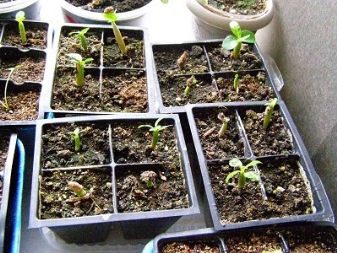
Layers
Consider how to root a rose using layering.
- In the spring, after removing the shelters and pruning, over the bud of one of the shoots is done small incision.
- A ditch with a depth of 7 to 10 cm is dug near the bush. Humus is poured onto its bottom, and then earth.
- The shoot is bent, placed in a groove, fixed with metal brackets, and then covered with soil mixture... In this case, the top of the shoot should remain outside.
- For layering it is necessary look afteras well as for adult culture.
- By the fall season, the shoots of the rose will release the first shoots that can already be transplanted. If the plant is located in a region with severe winters, then such an operation should be postponed until spring.
- Next, the twig is separated from the mother bush, the cuttings are cut off and transplanted to the main place. It will be necessary to take care of it, as well as for adult plants.
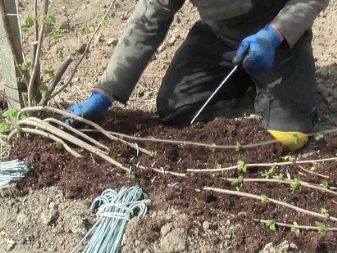
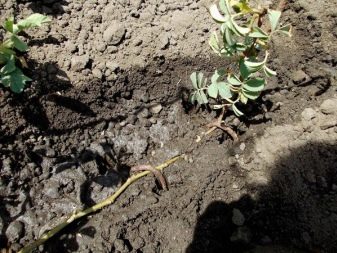
Diseases and pests
Most often, a climbing rose begins to hurt due to:
- improper care or its complete absence;
- bad weather conditions;
- soil contamination.
The following pests and ailments are dangerous for the culture.
- Black spot... May occur against a background of warm weather and heavy rain. It appears as black spots on the foliage, which then turns yellow and falls off. The disease is treated with copper sulfate (3% solution).
- Spider mite. It feeds on the sap of the foliage of a rose, braids the branches with cobwebs. Because of this, the leaves acquire an unnatural color, die off. You can fight the tick with a tincture of 300 g of fresh wormwood. The components are sent to a wooden container, filled with 10 liters of water and infused for 3 days. The plantings are sprayed over the ground, and the soil around is cultivated.
- Green aphid. It also sucks out all the juices from leaves, buds and stems. Leads to deformation and drying of green mass, as well as flowers. A soap solution can be used against aphids.
Spraying with this solution is carried out daily for two weeks.
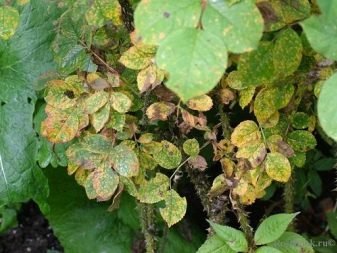


































































































The comment was sent successfully.